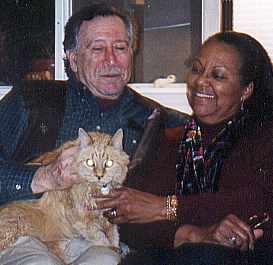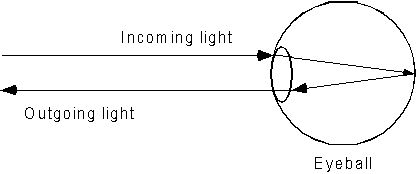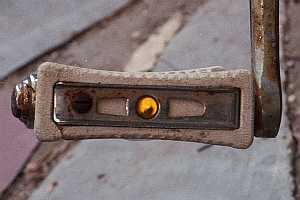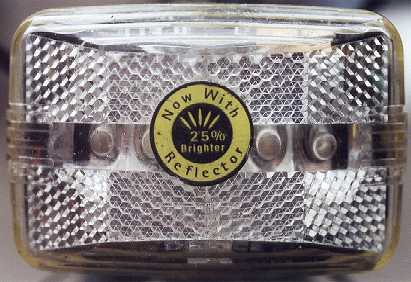| If you shine light on most objects, they reflect light like a mirror (specular
or glossy reflection) or else they return the light in all possible directions (diffuse
or dull reflection). Your bicycle's reflectors (or to use the technical term, "retroreflectors") are different. They send light back in the direction it came from. This property makes the reflectors appear unnaturally bright to an observer who is in nearly the same direction as the light source. Types of reflectorsHow do reflectors accomplish this optical trick? In either of two different ways. 1) "Cat's-eye" reflectorsThis photo was taken with a flashgun on the camera.
The cat's eyes focused the light from the flash onto a small spot on the retina (sensitive surface) at the back of each of the cat's eyeballs. The eyes work equally well to focus the light from these spots back toward the camera, as shown in the drawing below.
The tissue that underlies the cat's retina is yellow, while that of humans is red. For this reason, a cat's eyes put on a brighter, more exciting display than the "redeye" that sometimes shows up in flash photos of people. (The cat has better night vision than humans, because light can excite the sensitive cells of the retina twice. The cat's vision is blurry, because the light becomes unfocused in its two-way trip.) Large glass beads were once commonly used as cat's-eye reflectors. The photo below shows a single glass bead used as a pedal reflector on a 1964 Raleigh bicycle.
Today, the cat's-eye principle is used mostly in reflective paint, reflective plastic sheeting (commonly used in highway signs) and reflectorized tape. These all have millions of tiny glass beads, each of which works like a miniature cat's eye. The front surface of each bead is clear and works as a lens, while the rear surface of each bead has a mirror coating to reflect light back to the lens. 2) Cube corner reflectorsWhen mirrors are placed at a 90 degree angle to one another, they reflect light back in the same direction it came from.
The drawing shows only two dimensions. The real world is three-dimensional and so three mirrors are required, forming an inside corner of a cube. Reflectors used on bicycles have hundreds of small cube-corner elements. Each of the little hexagonal cells in the face of the Vistalite™ below, for example, is a cube corner element. The outer surface of the face plate is smooth, and the inner surface is formed into the cube-corner shapes, as you can see if you pry the cover off the Vistalite to replace its batteries. (Why the Vistalite manufacturers stuck their label in the middle of the face plate is another issue...)
Cube-corner reflectors like the one in the Vistalite are made of molded plastic. Reflective sheeting in leg bands, safety vests and some highway signs also uses the cube-corner principle. The cube-corner elements in the reflective sheeting are tiny -- you probably need a magnifying glass to see them. Next: When reflectors can work -- and when they can't. |




